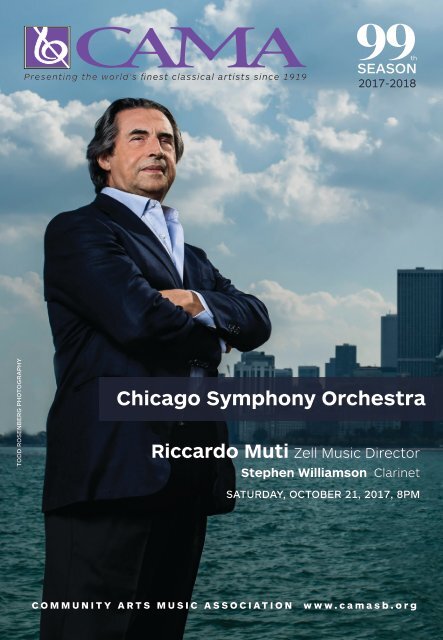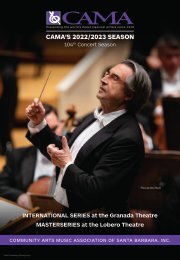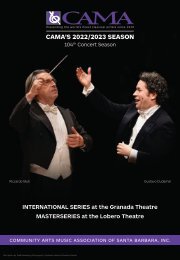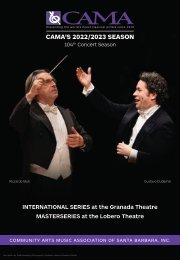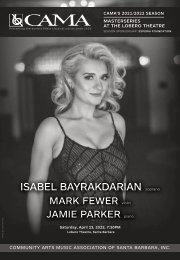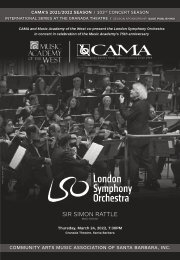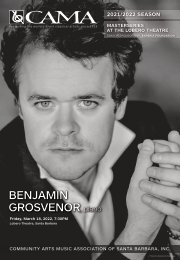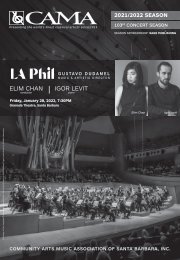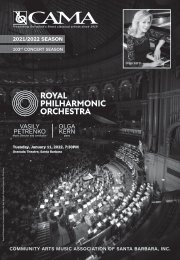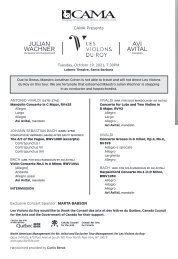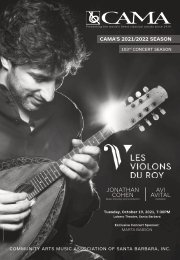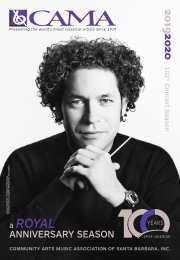CAMA presents Chicago Symphony Orchestra - October 21, 2017 - International Series at The Granada Theatre
Chicago Symphony Orchestra Saturday, October 21, 2017, The Granada Theatre, 8pm Riccardo Muti Music Director Stephen Williamson Clarinet Franz Schubert: Symphony No.8, D.759, “Unfinished” Wolfgang Amadeus Mozart: Clarinet Concerto in A Major, K.622 Robert Schumann: Symphony No.2 in C Major, Op.61 Not seen in Santa Barbara since 1987, the Chicago Symphony Orchestra is consistently hailed as one of the greatest orchestras in the world. In collaboration with the best conductors and guest artists on the international music scene, the CSO performs well over one hundred concerts each year at its downtown home, Symphony Center and at the Ravinia Festival on Chicago’s North Shore. Music lovers outside Chicago enjoy the sounds of the Chicago Symphony Orchestra through best-selling recordings and sold-out tour performances in the United States and around the globe. Maestro Riccardo Muti is one of the preeminent conductors of our day. In 2010, when he became the tenth music director of the Chicago Symphony Orchestra (CSO), he already had more than forty years of experience at the helm of the Maggio Musicale Fiorentino, Philharmonia Orchestra, Philadelphia Orchestra, and Teatro alla Scala.
Chicago Symphony Orchestra
Saturday, October 21, 2017, The Granada Theatre, 8pm
Riccardo Muti Music Director
Stephen Williamson Clarinet
Franz Schubert: Symphony No.8, D.759, “Unfinished”
Wolfgang Amadeus Mozart: Clarinet Concerto in A Major, K.622
Robert Schumann: Symphony No.2 in C Major, Op.61
Not seen in Santa Barbara since 1987, the Chicago Symphony Orchestra is consistently hailed as one of the greatest orchestras in the world. In collaboration with the best conductors and guest artists on the international music scene, the CSO performs well over one hundred concerts each year at its downtown home, Symphony Center and at the Ravinia Festival on Chicago’s North Shore. Music lovers outside Chicago enjoy the sounds of the Chicago Symphony Orchestra through best-selling recordings and sold-out tour performances in the United States and around the globe. Maestro Riccardo Muti is one of the preeminent conductors of our day. In 2010, when he became the tenth music director of the Chicago Symphony Orchestra (CSO), he already had more than forty years of experience at the helm of the Maggio Musicale Fiorentino, Philharmonia Orchestra, Philadelphia Orchestra, and Teatro alla Scala.
Create successful ePaper yourself
Turn your PDF publications into a flip-book with our unique Google optimized e-Paper software.
Presenting the world’s finest classical artists since 1919<br />
<strong>Chicago</strong> <strong>Symphony</strong> <strong>Orchestra</strong><br />
Riccardo Muti Zell Music Director<br />
Stephen Williamson Clarinet<br />
SATURDAY, OCTOBER <strong>21</strong>, <strong>2017</strong>, 8PM<br />
COMMUNITY ARTS MUSIC ASSOCIATION www.camasb.org
Presenting the world’s finest classical artists since 1919<br />
MASTERSERIES<br />
SEASON SPONSORSHIP:<br />
ESPERIA FOUNDATION<br />
Juilliard String Quartet<br />
SATURDAY, NOVEMBER 11, <strong>2017</strong>, LOBERO THEATRE, 8PM<br />
Joseph Lin Violin • Ronald Copes Violin<br />
Roger Tapping Viola • Astrid Schween Cello<br />
Franz Joseph Haydn: Quartet in D Major, Op.76, No.5<br />
Béla Bartók: Quartet No.5, Sz.102<br />
Antonín Dvořák: Quartet No.11 in C Major, Op.61<br />
Known through its performances and recordings as the quintessential American string quartet,<br />
the Juilliard String Quartet returns to the Lobero <strong>The</strong><strong>at</strong>re with new cellist Astrid Schween.<br />
In 2011, the multiple Grammy® Award-winning Quartet became the first classical music<br />
ensemble to receive a Lifetime Achievement Award from the N<strong>at</strong>ional Academy of Recording<br />
Arts and Sciences. Violinist Ronald Copes, a local favorite and former music faculty member <strong>at</strong><br />
UC Santa Barbara, has played violin II with this distinguished quartet since 1997.<br />
Single tickets on sale now<br />
Section: A $49 | B $39. Lobero <strong>The</strong><strong>at</strong>re Box Office<br />
(805) 963-0761 • lobero.com<br />
Simon Powis photo<br />
MASTER CLASS<br />
Presented by <strong>CAMA</strong> and the UCSB Department of Music<br />
Friday,<br />
November 10, <strong>2017</strong>, 5pm<br />
Karl Geiringer Hall, UCSB Department of Music<br />
Fe<strong>at</strong>uring<br />
Ronald Copes and Astrid Schween<br />
of the Juilliard String Quartet<br />
and students from the UCSB<br />
Department of Music<br />
FREE AND OPEN TO THE PUBLIC
Presenting the world’s finest classical artists since 1919<br />
INTERNATIONAL SERIES <strong>at</strong> <strong>The</strong> GRANADA THEATRE<br />
SEASON SPONSORSHIP: SAGE PUBLICATIONS<br />
Riccardo Muti, Conductor<br />
Stephen Williamson, Clarinet<br />
S<strong>at</strong>urday, <strong>October</strong> <strong>21</strong>, <strong>2017</strong>, 8pm<br />
<strong>The</strong> <strong>Granada</strong> <strong>The</strong><strong>at</strong>re (Santa Barbara Center for the Performing Arts)<br />
FRANZ SCHUBERT<br />
(1797-1828)<br />
WOLFGANG AMADEUS<br />
MOZART<br />
(1756-1791)<br />
INTERMISSION<br />
ROBERT SCHUMANN<br />
(1810-1856)<br />
<strong>Symphony</strong> No.8 in B minor, D.759 (Unfinished)<br />
Allegro moder<strong>at</strong>o<br />
Andante con moto<br />
Clarinet Concerto in A Major, K.622<br />
Allegro<br />
Adagio<br />
Rondo: Allegro<br />
Stephen Williamson, Clarinet<br />
<strong>Symphony</strong> No.2 in C Major, Op.61<br />
Sostenuto assai—Allegro ma non troppo<br />
Scherzo: Allegro vivace<br />
Adagio expressive<br />
Allegro molto vivace<br />
Programs and artists subject to change<br />
BANK OF AMERICA IS THE GLOBAL SPONSOR<br />
OF THE CHICAGO SYMPHONY ORCHESTRA.<br />
<strong>Intern<strong>at</strong>ional</strong> <strong>Series</strong> Season Sponsor: SAGE Public<strong>at</strong>ions<br />
<strong>CAMA</strong> gr<strong>at</strong>efully dedic<strong>at</strong>es this performance by the<br />
<strong>Chicago</strong> <strong>Symphony</strong> <strong>Orchestra</strong> in remembrance of Léni Fé Bland.<br />
We request th<strong>at</strong> you switch off cellular phones, w<strong>at</strong>ch alarms and pager signals during the<br />
performance. <strong>The</strong> photographing or sound recording of this concert or possession of any device<br />
for such photographing or sound recording is prohibited.<br />
COMMUNITY ARTS MUSIC ASSOCIATION | www.camasb.org
Biography<br />
<strong>Chicago</strong><br />
<strong>Symphony</strong><br />
<strong>Orchestra</strong><br />
<strong>The</strong> <strong>Chicago</strong> <strong>Symphony</strong> <strong>Orchestra</strong><br />
(CSO) is consistently hailed as one of<br />
the gre<strong>at</strong>est orchestras in the world. Its<br />
music director since 2010 is Riccardo<br />
Muti, one of the preeminent conductors<br />
of our day. Founded in 1891 by its first<br />
music director, <strong>The</strong>odore Thomas, the<br />
CSO’s other illustrious music directors<br />
include Frederick Stock, Désiré Defauw,<br />
Artur Rodzinski, Rafael Kubelík, Fritz Reiner,<br />
Jean Martinon, Sir Georg Solti, and Daniel<br />
Barenboim. From 2006 to 2010, Bernard<br />
Haitink served as principal conductor, the<br />
first in CSO history. Pierre Boulez was<br />
appointed principal guest conductor in<br />
1995 and then named Helen Regenstein<br />
Conductor Emeritus in 2006, a position<br />
he held until his de<strong>at</strong>h in January 2016.<br />
Celebr<strong>at</strong>ed cellist Yo-Yo Ma was appointed<br />
the CSO’s Judson and Joyce Green Cre<strong>at</strong>ive<br />
Consultant in 2010. Samuel Adams and<br />
Elizabeth Ogonek were appointed the CSO’s<br />
Mead Composers-in-Residence in 2015.<br />
<strong>The</strong> renowned musicians of the CSO
Since 1916, recording has been significant in<br />
establishing the <strong>Orchestra</strong>’s intern<strong>at</strong>ional reput<strong>at</strong>ion,<br />
with recordings by the CSO earning a total of<br />
62 Grammy ® awards...<br />
command a vast repertoire th<strong>at</strong> spans<br />
from baroque to new music. <strong>The</strong>y annually<br />
perform more than 150 concerts, most<br />
<strong>at</strong> <strong>Symphony</strong> Center in <strong>Chicago</strong>, and,<br />
since 1936, in the summer <strong>at</strong> the Ravinia<br />
Festival. <strong>The</strong> CSO also tours n<strong>at</strong>ionally and<br />
intern<strong>at</strong>ionally. Since its first tour to Canada<br />
in 1892, the <strong>Orchestra</strong> has performed in<br />
29 countries on five continents during<br />
60 intern<strong>at</strong>ional tours.<br />
Since 1916, recording has been<br />
significant in establishing the <strong>Orchestra</strong>’s<br />
intern<strong>at</strong>ional reput<strong>at</strong>ion, with recordings<br />
by the CSO earning a total of 62 Grammy<br />
awards from the N<strong>at</strong>ional Academy of<br />
Recording Arts and Sciences. In 2007,<br />
the CSO launched an independent label,<br />
CSO Resound. <strong>The</strong> 2010 release of Verdi’s<br />
Messa da Requiem was recognized with<br />
two Grammy awards. Listeners and fans<br />
around the world can hear the CSO in<br />
weekly airings of the CSO Radio Broadcast<br />
<strong>Series</strong>, which is syndic<strong>at</strong>ed on the WFMT<br />
Radio Network and online <strong>at</strong> CSO.org/<br />
Radio. In addition, the CSO’s YouTube video<br />
of Beethoven’s <strong>Symphony</strong> No.9, conducted<br />
by Muti, has received over seven million<br />
views.<br />
Annually, the CSO engages more than<br />
200,000 people of diverse ages, incomes,<br />
and backgrounds through the innov<strong>at</strong>ive<br />
programs of the Negaunee Music Institute<br />
<strong>at</strong> the CSO. <strong>The</strong> Institute also manages the<br />
Civic <strong>Orchestra</strong> of <strong>Chicago</strong>, the only preprofessional<br />
training ensemble of its kind<br />
affili<strong>at</strong>ed with a major American orchestra.<br />
<strong>The</strong> parent organiz<strong>at</strong>ion for the CSO<br />
is the <strong>Chicago</strong> <strong>Symphony</strong> <strong>Orchestra</strong><br />
Associ<strong>at</strong>ion (CSOA), which also includes<br />
the acclaimed <strong>Chicago</strong> <strong>Symphony</strong> Chorus,<br />
directed by Duain Wolfe. Under the<br />
banner of its present<strong>at</strong>ion series, entitled<br />
<strong>Symphony</strong> Center Presents, the CSOA<br />
annually <strong>presents</strong> dozens of prestigious<br />
guest artists and ensembles from a variety<br />
of musical genres—classical, jazz, pop,<br />
world, and contemporary.<br />
Thousands of p<strong>at</strong>rons, volunteers,<br />
and donors—corpor<strong>at</strong>ions, found<strong>at</strong>ions,<br />
government agencies and individuals—<br />
support the CSOA each year. <strong>The</strong> CSO’s<br />
music director position is endowed in<br />
perpetuity by a generous gift from the<br />
Zell Family Found<strong>at</strong>ion. <strong>The</strong> Negaunee<br />
Found<strong>at</strong>ion provides generous support in<br />
perpetuity for the work of the Negaunee<br />
Music Institute. t<br />
Global Sponsor of the CSO
Biography<br />
Riccardo<br />
Muti<br />
Born in Naples, Italy, Riccardo Muti is<br />
one of the preeminent conductors of our<br />
day. In 2010, when he became the tenth<br />
music director of the <strong>Chicago</strong> <strong>Symphony</strong><br />
<strong>Orchestra</strong> (CSO), he had more than forty<br />
years of experience <strong>at</strong> the helm of Maggio<br />
Musicale Fiorentino (1968–1980), the<br />
Philharmonia <strong>Orchestra</strong> (1973–1982), the<br />
Philadelphia <strong>Orchestra</strong> (1980–1992), and<br />
Te<strong>at</strong>ro alla Scala (1986–2005).<br />
Muti studied piano under Vincenzo Vitale<br />
<strong>at</strong> the Conserv<strong>at</strong>ory of San Pietro a Majella<br />
in Naples and subsequently received a<br />
diploma in composition and conducting<br />
from the Giuseppe Verdi Conserv<strong>at</strong>ory in<br />
Milan. His principal teachers were Bruno<br />
Bettinelli and Antonino Votto, principal<br />
assistant to Arturo Toscanini <strong>at</strong> La Scala.<br />
After he won the Guido Cantelli Conducting<br />
Competition in Milan in 1967, Muti’s career<br />
developed quickly.<br />
Herbert von Karajan invited him to<br />
conduct <strong>at</strong> the Salzburg Festival in Austria<br />
in 1971, and Muti has maintained a close<br />
rel<strong>at</strong>ionship with the summer festival<br />
and with its gre<strong>at</strong> orchestra, the Vienna<br />
Philharmonic, for more than forty-five<br />
years. He has received the distinguished
Passion<strong>at</strong>e about teaching young musicians,<br />
Maestro Muti founded the Luigi Cherubini Youth<br />
<strong>Orchestra</strong> in 2004 and the Riccardo Muti Italian<br />
Opera Academy in 2015 to pass on the Italian opera<br />
tradition to young conductors and répétiteurs.<br />
Golden Ring and the Otto Nicolai Gold<br />
Medal from the Philharmonic for his<br />
outstanding artistic contributions to the<br />
orchestra. He also is a recipient of a<br />
silver medal from the Salzburg Mozarteum<br />
and the Golden Johann Strauss Award<br />
by the Johann Strauss Society of Vienna.<br />
He is an honorary member of Vienna’s<br />
Gesellschaft der Musikfreunde, the Vienna<br />
Hofmusikkapelle, the Vienna Philharmonic,<br />
and the Vienna St<strong>at</strong>e Opera.<br />
In addition to his distinguished<br />
appointments as music director, Muti<br />
has received innumerable intern<strong>at</strong>ional<br />
honors. He is a Cavaliere di Gran Croce of<br />
the Italian Republic, Officer of the French<br />
Legion of Honor, and a recipient of the<br />
German Verdienstkreuz. Queen Elizabeth<br />
II bestowed on him the title of honorary<br />
Knight Commander of the British Empire,<br />
Russian President Vladimir Putin awarded<br />
him the Order of Friendship, and Pope<br />
Benedict XVI made him a Knight of the<br />
Grand Cross First Class of the Order of<br />
Saint Gregory the Gre<strong>at</strong>—the highest<br />
papal honor. Muti also has received<br />
Israel’s Wolf Prize for the arts, Sweden’s<br />
prestigious Birgit Nilsson Prize, Spain’s<br />
Prince of Asturias Award for the Arts,<br />
Japan’s Order of the Rising Sun, Gold and<br />
Silver Star decor<strong>at</strong>ion, and the gold medal<br />
from Italy’s Ministry of Foreign Affairs<br />
as well as the prestigious “Presidente<br />
della Repubblica” award from the Italian<br />
government. He has received more than<br />
twenty honorary degrees from universities<br />
around the world.<br />
Passion<strong>at</strong>e about teaching young<br />
musicians, Muti founded the Luigi<br />
Cherubini Youth <strong>Orchestra</strong> in 2004 and the<br />
Riccardo Muti Italian Opera Academy in<br />
2015 to pass on the Italian opera tradition<br />
to young conductors and répétiteurs.<br />
Through Le vie dell’Amicizia, a project<br />
of the Ravenna Festival in Italy, he has<br />
conducted in many of the world’s most<br />
troubled areas in order to bring <strong>at</strong>tention<br />
to and advoc<strong>at</strong>e for civic and social issues.<br />
Riccardo Muti’s vast c<strong>at</strong>alog of<br />
recordings, numbering in the hundreds,<br />
ranges from the traditional symphonic<br />
and oper<strong>at</strong>ic repertoires to contemporary<br />
works. He also has written two books,<br />
Verdi, l’italiano and Riccardo Muti: An<br />
Autobiography: First the Music, <strong>The</strong>n<br />
the Words, both of which have been<br />
published in several languages.t<br />
www.riccardomutimusic.com
Biography<br />
Stephen<br />
Williamson Clarinet<br />
Stephen Williamson is principal clarinet<br />
of the <strong>Chicago</strong> <strong>Symphony</strong> <strong>Orchestra</strong><br />
under Riccardo Muti. Williamson formerly<br />
was principal clarinet of both the New<br />
York Philharmonic (2013–14) and the<br />
Metropolitan Opera <strong>Orchestra</strong> (2003–11).<br />
In addition, he has been a frequent guest<br />
principal clarinet with the Saito Kinen<br />
Festival <strong>Orchestra</strong> in Japan under Seiji<br />
Ozawa.<br />
Williamson currently is a faculty<br />
member of DePaul University in <strong>Chicago</strong>,<br />
Illinois. He also has served on the faculty<br />
<strong>at</strong> Columbia University and the Mannes<br />
College of Music in New York City, as<br />
well as <strong>at</strong> the Pacific Music Festival in<br />
Sapporo, Japan. He has recorded for the<br />
Sony Classics, Telarc, CRI, BMG, Naxos,<br />
and Decca labels, and can be heard on<br />
numerous film soundtracks. He was a<br />
fe<strong>at</strong>ured soloist with the CSO under John<br />
Williams, recording his Oscar-nomin<strong>at</strong>ed<br />
score for Steven Spielberg’s film Lincoln.<br />
An avid soloist and chamber musician,<br />
Stephen Williamson has performed<br />
extensively in the United St<strong>at</strong>es, Europe,<br />
and Asia. He has collabor<strong>at</strong>ed with such<br />
artists as James Levine, Yo-Yo Ma, Mitsuko<br />
Uchida, Jeffrey Kahane, Anne-Marie<br />
McDermott, Emanuel Ax, and Meliora<br />
Winds; the Aspen, Dorian, and Sylvan wind<br />
quintets; and the Brentano, American,<br />
Jasper, Brasilia, and Dover string quartets.<br />
Past concerto performances include<br />
Mozart’s Clarinet Concerto with the CSO<br />
(2016), the Pacific Music Festival <strong>Orchestra</strong><br />
in Japan (2011), and the Metropolitan<br />
Opera <strong>Orchestra</strong> in Carnegie Hall under<br />
conductor Fabio Luisi (2012).<br />
Williamson received his bachelor’s<br />
degree and performer’s certific<strong>at</strong>e from<br />
the Eastman School of Music, and his<br />
master’s degree from the Juilliard School.<br />
As a Fulbright scholar, he furthered his<br />
studies <strong>at</strong> the Hochschule der Künste in<br />
Berlin, where he collabor<strong>at</strong>ed with various<br />
members of the Berlin Philharmonic. His<br />
past teachers include Peter Rieckhoff,<br />
Charles Neidich, Kenneth Grant, and<br />
Michael Webster. He was the grand-prize<br />
winner of the 1994 Boosey & Hawkes/<br />
Buffet Crampon First Annual North<br />
American Clarinet Competition. Other past<br />
awards include the Concert Artists Guild<br />
Competition and the Coleman <strong>Intern<strong>at</strong>ional</strong><br />
Chamber Music Competition.<br />
A longtime Selmer-Paris and Vandoren<br />
Artist, Williamson currently plays Selmer<br />
Sign<strong>at</strong>ure clarinets and uses Vandoren<br />
traditional reeds with a James Pyne JX/<br />
BC mouthpiece. He resides in Wilmette,<br />
Illinois, with his wife Jill and their sons<br />
Ryan, Connor, and M<strong>at</strong>thew and their dog<br />
Lila and c<strong>at</strong> Ruby. t
Program Notes<br />
Franz Schubert<br />
Born January 31, 1797; Himmelpfortgrund, northwest of Vienna, Austria<br />
Died November 19, 1828; Vienna, Austria<br />
<strong>Symphony</strong> No.8 in B minor,<br />
D.759 (Unfinished)<br />
COMPOSED<br />
manuscript d<strong>at</strong>ed <strong>October</strong> 30, 1822<br />
FIRST PERFORMANCE<br />
December 17, 1865; Vienna, Austria<br />
INSTRUMENTATION<br />
two flutes, two oboes, two clarinets,<br />
two bassoons, two horns, two trumpets,<br />
three trombones, timpani, strings<br />
APPROXIMATE PERFORMANCE TIME<br />
22 minutes<br />
FIRST CSO PERFORMANCES<br />
<strong>October</strong> 30 and 31, 1891, Auditorium <strong>The</strong><strong>at</strong>re.<br />
<strong>The</strong>odore Thomas conducting<br />
July 5, 1936, Ravinia Festival. Ernest Ansermet<br />
conducting<br />
CSO RECORDINGS<br />
1954. Antal Doráti conducting. Mercury<br />
1958. Bruno Walter conducting. CSO (<strong>Chicago</strong><br />
<strong>Symphony</strong> <strong>Orchestra</strong> in the Twentieth Century:<br />
Collector’s Choice)<br />
1960. Fritz Reiner conducting. RCA<br />
1968. Seiji Ozawa conducting. RCA<br />
1978. Carlo Maria Giulini conducting. Deutsche<br />
Grammophon<br />
1979. Sir Georg Solti conducting. EuroArts<br />
(video)<br />
We don’t know why Schubert never finished<br />
his B-minor symphony. This has been one<br />
of music’s gre<strong>at</strong> unanswered questions for<br />
more than a hundred years, and, despite<br />
some intelligent specul<strong>at</strong>ion, we still come<br />
up empty-handed today. At least we know<br />
th<strong>at</strong> he didn’t finish it. For many years,<br />
music lovers persisted in believing th<strong>at</strong> the<br />
missing movements s<strong>at</strong>, forgotten, in some<br />
Viennese <strong>at</strong>tic. On the other hand, scholars<br />
no longer suggest th<strong>at</strong> Schubert intended<br />
to write a two-movement symphony, giving<br />
the composer credit for a bold stroke th<strong>at</strong>,<br />
for all his daring, is not his.<br />
<strong>The</strong> facts are scarce and mysterious,<br />
which has only heightened the intrigue over<br />
the years. <strong>The</strong>re was no mention of this<br />
symphony made during the composer’s<br />
lifetime. It lay buried, like hidden treasure,<br />
in Anselm Hüttenbrenner’s cluttered study<br />
until the 1860s—more than thirty years after
Schubert’s de<strong>at</strong>h—when it was dusted off<br />
to take its place as No.8 among the known<br />
Schubert symphonies.<br />
<strong>The</strong> full score, clearly written in Schubert’s<br />
own hand, is d<strong>at</strong>ed 30 <strong>October</strong> 1822,<br />
Vienna, and signed, with his characteristic<br />
flourish, Franz Schubert. <strong>The</strong> manuscript,<br />
headed “<strong>Symphony</strong> in B minor,” includes two<br />
movements: a wonderful, singing Allegro<br />
moder<strong>at</strong>o and a heartbreaking Andante con<br />
moto—both so sublime th<strong>at</strong> the Unfinished<br />
nickname is all the more frustr<strong>at</strong>ing. On the<br />
back of the final page of the Andante are<br />
nine measures of a scherzo, fully scored,<br />
followed by four blank pages. In the 1960s,<br />
Christa Landon discovered a missing leaf<br />
th<strong>at</strong> ought to have come before the empty<br />
pages, containing measures ten through<br />
twenty and then stopping abruptly, as if<br />
Schubert had been interrupted mid-thought.<br />
(A piano sketch of the symphony shows th<strong>at</strong><br />
Schubert had planned the entire scherzo<br />
and the beginning of a trio.)<br />
We don’t know wh<strong>at</strong> interrupted<br />
Schubert, but a number of theories have<br />
been proposed. This was, after all, a time<br />
of many unfinished instrumental works:<br />
from February 1818 to November 1822,<br />
he started and set aside three—possibly<br />
four—different symphonies. L<strong>at</strong>e in 1822,<br />
Schubert contracted syphilis and began to<br />
suffer from depression and failing health.<br />
He also was nearly paralyzed by a growing<br />
awareness of Beethoven’s extraordinary<br />
symphonic work—music th<strong>at</strong> blazed new<br />
p<strong>at</strong>hs in an area in which Schubert felt the<br />
least assured. (Schubert often struggled<br />
with the compositional process, even though<br />
it’s true th<strong>at</strong> a song once came so easily to<br />
him th<strong>at</strong> he jotted it down, fully formed, on<br />
the back of a menu.)<br />
Perhaps Schubert was trying to face<br />
down the giant using the language they both<br />
understood best. He was always too shy to<br />
contact Beethoven, even though they lived<br />
in the same city for years. (When Beethoven<br />
was so deaf th<strong>at</strong> he provided books for<br />
visitors to write down wh<strong>at</strong> they wanted to<br />
say, his nephew Karl mentioned, in August<br />
1823: “<strong>The</strong>y gre<strong>at</strong>ly praise Schubert, but<br />
it is said th<strong>at</strong> he hides himself.”) <strong>The</strong> two<br />
men met only once, when Schubert went to<br />
visit Beethoven on his de<strong>at</strong>hbed with Josef<br />
and Anselm Hüttenbrenner, the brothers<br />
who already had Schubert’s unfinished<br />
symphony in their possession.<br />
When Schubert abandoned work on the<br />
B-minor symphony, he gave it to Josef<br />
Hüttenbrenner, probably in 1823, after<br />
ripping out the unfinished scherzo. (<strong>The</strong> first<br />
nine measures remained simply because<br />
they were written on the back of the Andante.)<br />
At some point, Josef gave the manuscript<br />
to his brother Anselm, who shoved it in<br />
the back of a drawer. (A score by Schubert<br />
th<strong>at</strong> remained in Josef’s possession—music<br />
for Goethe’s Claudine von Villa Bella—was<br />
used by his servants as kindling sometime<br />
in 1848.) On March 8, 1860, in a letter to<br />
Johann Herbeck, an influential Viennese<br />
musician, Josef casually mentioned th<strong>at</strong><br />
Anselm “possesses a treasure in Schubert’s<br />
B minor symphony, which we rank with his<br />
Gre<strong>at</strong> C-Major symphony, his instrumental<br />
swan song, and with all the symphonies of<br />
Beethoven—only it is unfinished.” Herbeck
would never forget the morning some<br />
five years l<strong>at</strong>er when he actually held the<br />
manuscript in his hands.<br />
<strong>The</strong> <strong>at</strong>tempts to round off Schubert’s<br />
score—as if two polished, magnificent<br />
movements were somehow uns<strong>at</strong>isfactory—<br />
began with the very first performance on<br />
December 17, 1865, when the finale of<br />
Schubert’s Third <strong>Symphony</strong> was tacked on<br />
to ensure a rousing finish. Over the years,<br />
other endings have been proposed. (In 1928,<br />
the Columbia Gramophone Company even<br />
considered hosting a competition for the best<br />
completion of the Unfinished <strong>Symphony</strong>.)<br />
<strong>The</strong>re have always been those who claimed<br />
th<strong>at</strong> Schubert actually finished the symphony,<br />
and, as recently as 1942, it was suggested<br />
th<strong>at</strong> Anselm Hüttenbrenner had lost the<br />
manuscript of the last two movements.<br />
Today, convinced by the evidence th<strong>at</strong><br />
Schubert’s Unfinished <strong>Symphony</strong> was, in fact,<br />
never finished, we are more willing to accept<br />
the brilliance of wh<strong>at</strong> we have r<strong>at</strong>her than<br />
long for wh<strong>at</strong> we do not.<br />
Imagine the joy of uncovering one of<br />
music’s true masterworks. Even Eduard<br />
Hanslick, as demanding (and sometimes<br />
as nasty) as any critic in the nineteenth<br />
century, quickly turned to butter when he<br />
reviewed the first performance in 1865:<br />
When, after the few introductory<br />
measures, clarinets and oboes in unison<br />
begin to sound their sweet song above the<br />
peaceful murmur of the violins, then each<br />
and every child recognizes the composer,<br />
and a half-suppressed outcry “Schubert”<br />
buzzes through the hall. He has hardly<br />
entered, but it is as if one knows him by his<br />
step, by his manner of lifting the l<strong>at</strong>ch.<br />
We now know Schubert perhaps best<br />
of all by th<strong>at</strong> sweet song, and there are<br />
gener<strong>at</strong>ions of schoolchildren who may<br />
never forget those unfortun<strong>at</strong>e words—“This<br />
is the symphony th<strong>at</strong> Schubert wrote and<br />
never finished”—th<strong>at</strong> eager music teachers<br />
have added to the lovely cello melody th<strong>at</strong><br />
follows. <strong>The</strong> p<strong>at</strong>hos and beauty of this<br />
entire stretch of music is extraordinary, but<br />
even more remarkable is the way Schubert<br />
sustains the spell throughout the movement<br />
and on into the second. Schubert’s sketches<br />
show th<strong>at</strong> he originally wanted to end his<br />
first movement in B Major—which would<br />
have broken the mood—but he thought<br />
better of it, leaving us instead in the dark<br />
recesses of B minor.<br />
<strong>The</strong> slow movement—and it is only<br />
rel<strong>at</strong>ively slow, for Schubert specifies Andante<br />
con moto (with motion)—is in the unexpected<br />
key of E Major, where he would again uncover<br />
gre<strong>at</strong> riches in the Adagio of the C-Major<br />
string quintet. In this lovely movement, a few<br />
especially eloquent details stand out: the<br />
high-flying clarinet solo th<strong>at</strong> gently sails over<br />
shifting chords, and a wonderful moment of<br />
total stillness, disturbed only by the octave<br />
call of the horn, just before Schubert leads us<br />
back to the opening.<br />
And it is here, with this perfect Andante,<br />
th<strong>at</strong> we must stop. Schubert’s plans for the<br />
third-movement scherzo look promising—it<br />
begins with a strong theme, first played in<br />
octaves by the full orchestra. <strong>The</strong>re is no<br />
telling wh<strong>at</strong> might have emerged had he<br />
polished this raw m<strong>at</strong>erial into something as<br />
fine as the two movements we know so well.
Program Notes<br />
Wolfgang Amadeus<br />
Mozart<br />
Born January 27, 1756; Salzburg, Austria<br />
Died December 5, 1791; Vienna, Austria<br />
Clarinet Concerto in A Major,<br />
K.622<br />
COMPOSED<br />
September–November 1791<br />
FIRST PERFORMANCE<br />
D<strong>at</strong>e unknown<br />
INSTRUMENTATION<br />
solo clarinet, two flutes, two bassoons, two<br />
horns, strings<br />
APPROXIMATE PERFORMANCE TIME<br />
28 minutes<br />
FIRST CSO PERFORMANCES<br />
July 25, 1957, Ravinia Festival. Reginald Kell as<br />
soloist, Georg Solti conducting<br />
November 18, 1961, <strong>Orchestra</strong> Hall. Clark Brody<br />
as soloist, John Weicher conducting<br />
This concerto is the last important work<br />
Mozart finished before his de<strong>at</strong>h. He<br />
recorded it in his personal c<strong>at</strong>alog without<br />
a d<strong>at</strong>e, right after <strong>The</strong> Magic Flute and La<br />
clemenza di Tito. <strong>The</strong> only l<strong>at</strong>er entry is the<br />
little Masonic Cant<strong>at</strong>a, d<strong>at</strong>ed November 15,<br />
1791. <strong>The</strong> Requiem, as we know, didn’t<br />
make it into the list.<br />
For decades the history of the Requiem<br />
was full of ambiguity, while th<strong>at</strong> of the<br />
Clarinet Concerto seemed quite clear.<br />
But in recent years, as we learned more<br />
about the unfinished Requiem, questions<br />
about the concerto began to emerge. <strong>The</strong><br />
Requiem riddles are now largely solved,<br />
damaging a fair amount of romantic myth<br />
and cinem<strong>at</strong>ic drama in the process.<br />
But an accur<strong>at</strong>e account of the Clarinet<br />
Concerto seems more uncertain today<br />
than ever.<br />
Let’s start with Anton Stadler. Mozart<br />
tells us th<strong>at</strong> he wrote the concerto for<br />
this gre<strong>at</strong> virtuoso clarinet player, a<br />
close friend, a fellow Mason (although<br />
a member of a different lodge), and, on<br />
numerous occasions, a spirited gambling<br />
companion. Mozart enjoyed Stadler’s<br />
friendship and admired his talent, easily<br />
accepting th<strong>at</strong> the l<strong>at</strong>ter was infinitely<br />
more generous and reliable than the<br />
former. <strong>The</strong> musical skill was evidently
prodigious: “One would never have<br />
thought,” wrote a critic in 1785, “th<strong>at</strong> a<br />
clarinet could imit<strong>at</strong>e the human voice<br />
to such perfection.” But Sophie Haibel,<br />
Mozart’s sister-in-law, remembered Stadler<br />
as one of the composer’s “false friends,<br />
secret bloodsuckers, and worthless<br />
persons who served only to amuse him<br />
<strong>at</strong> the table and intercourse with whom<br />
injured his reput<strong>at</strong>ion.” Perhaps she had<br />
learned from Constanze of the 500 gulden<br />
Mozart lent Stadler, a hefty sum th<strong>at</strong><br />
was still unpaid when officials tallied the<br />
composer’s est<strong>at</strong>e.<br />
Stadler’s true debt to Mozart is one<br />
clarinetists still owe him today: pages<br />
upon pages of music as precious as any<br />
in the repertory. It’s likely th<strong>at</strong> Mozart<br />
first heard Stadler play in March 1784, in<br />
a performance of his B-fl<strong>at</strong> wind serenade<br />
(K.361). <strong>The</strong> Clarinet Trio, written two years<br />
l<strong>at</strong>er and supposedly finished in a bowling<br />
alley on one of the many occasions when<br />
Mozart couldn’t separ<strong>at</strong>e music from life,<br />
may have been composed with Stadler in<br />
mind. By 1789, the year of the magnificent<br />
Quintet for Clarinet and Strings (K.581),<br />
virtually every note Mozart wrote for the<br />
instrument, including the added clarinet<br />
parts for the gre<strong>at</strong> G minor symphony, was<br />
written for Stadler.<br />
We now come to the last year of<br />
Mozart’s life. In l<strong>at</strong>e August 1791,<br />
Mozart set off for Prague to supervise<br />
the first performances of La clemenza<br />
di Tito, accompanied by Stadler, who<br />
was to play in the Prague orchestra;<br />
Franz Xaver Süssmayr, who would soon<br />
inherit the task of finishing the Requiem;<br />
and Constanze. Mozart worked on the<br />
opera in the coach, writing two virtuoso<br />
obblig<strong>at</strong>o solos for Stadler. <strong>The</strong> premiere<br />
on September 6 was decently received,<br />
though the empress Maria Luisa is said<br />
to have shouted from her box, “Una<br />
porcheria tedesca!” (“German rubbish,”<br />
to use the imperial transl<strong>at</strong>ion.) Mozart<br />
returned home to Vienna, leaving Stadler<br />
behind to accept thunderous applause<br />
and cheers from his fellow orchestra<br />
members for his big solos each night.<br />
On September 28, Mozart entered <strong>The</strong><br />
Magic Flute in his c<strong>at</strong>alog; the premiere,<br />
two nights l<strong>at</strong>er in a suburban Viennese<br />
the<strong>at</strong>er, was only a partial success.<br />
Sometime in the middle of this crazy<br />
schedule—two opera premieres in less<br />
than a month, plus work on a requiem<br />
th<strong>at</strong> had recently Gustav Mahler, been photo commissioned<br />
by<br />
through a mysterious Adolph E. Bieber-Kohut messenger—Mozart<br />
(1900)<br />
began wh<strong>at</strong> would be his last concerto, for<br />
Stadler’s clarinet. But there’s no mention<br />
of the concerto until <strong>October</strong> 7, when<br />
Mozart wrote to Constanze, who had gone<br />
to Baden, boasting th<strong>at</strong> after she left he<br />
played two games of billiards, sold his<br />
horse for fourteen duc<strong>at</strong>s, sent out for<br />
black coffee, and smoked a splendid pipe<br />
of tobacco before orchestr<strong>at</strong>ing “almost<br />
the whole Rondo for Stadler.” A letter<br />
d<strong>at</strong>ed <strong>October</strong> 14 (Mozart’s last) describes<br />
the evening Mozart took Salieri to see <strong>The</strong><br />
Magic Flute, an outing unfairly embellished<br />
in Peter Shaffer’s Amadeus. Little more<br />
than a month l<strong>at</strong>er, Mozart fell ill; he died<br />
in less than three weeks.
We come now to the questions, some<br />
still unanswered. Around the time Mozart<br />
met Anton Stadler, he had begun to play a<br />
large new clarinet—today called a basset<br />
clarinet, though in Mozart’s day it had no<br />
particular name. This curious instrument<br />
extended the clarinet’s glorious lower<br />
register down a Major third, reaching four<br />
new deep and resonant notes. It seems<br />
clear th<strong>at</strong> this is the instrument Mozart<br />
had in mind when he wrote both the<br />
celebr<strong>at</strong>ed quintet and this final concerto.<br />
But by the time the Clarinet Concerto<br />
was published, a decade after Mozart’s<br />
de<strong>at</strong>h, Stadler’s basset clarinet had gone<br />
out of favor, and the concerto was printed<br />
in a version rewritten for the narrower<br />
range of the standard clarinet. Even<br />
though a contemporary review argued<br />
th<strong>at</strong> this wasn’t the music Mozart wrote,<br />
and Stadler was still alive to protest,<br />
players and audiences quickly came to<br />
accept this revised version. Mozart’s<br />
autograph score has been lost. <strong>The</strong>re is,<br />
however, a fragment, 199 measures long<br />
and written entirely in Mozart’s hand, of<br />
a concerto in G for basset horn (another<br />
ancient member of the clarinet family) th<strong>at</strong><br />
nearly duplic<strong>at</strong>es more than half of the<br />
first movement of the Clarinet Concerto.<br />
Apparently Mozart first conceived this<br />
music for basset horn, perhaps as early<br />
as 1787, and l<strong>at</strong>er rewrote and finished it<br />
for Stadler’s modified clarinet. We can’t be<br />
sure for whom the earlier concerto was<br />
intended, nor why he chose to rewrite it<br />
for Stadler <strong>at</strong> one of the most hectic times<br />
in his life. But we do know th<strong>at</strong> Mozart<br />
had nothing to do with the version<br />
for standard clarinet—the one th<strong>at</strong><br />
gener<strong>at</strong>ions of musicians have come to<br />
love, and the one th<strong>at</strong> Stephen Williamson<br />
performs this week.<br />
<strong>The</strong> concerto is one of Mozart’s<br />
most personal cre<strong>at</strong>ions; like the final<br />
piano concerto, it’s as intim<strong>at</strong>e and<br />
convers<strong>at</strong>ional as chamber music, r<strong>at</strong>her<br />
than grand and dram<strong>at</strong>ic. We can’t<br />
blame historians—or playwrights for th<strong>at</strong><br />
m<strong>at</strong>ter—for suggesting Mozart knew<br />
his time was running out, for the music<br />
implies as much. <strong>The</strong> slow movement<br />
carries an almost unn<strong>at</strong>ural burden of<br />
sadness on its simple phrases; it is one of<br />
Mozart’s gre<strong>at</strong>est arias and a testament<br />
to the power of music to say wh<strong>at</strong> words<br />
cannot. Of the two outer movements, with<br />
their endless, n<strong>at</strong>ural lyricism, no words<br />
are more apt than those Mozart scholar<br />
H.C. Robbins Landon remembered from<br />
Shakespeare: “<strong>The</strong> heart dances, but not<br />
for joy.”
Program Notes<br />
Robert<br />
Schumann<br />
Born June 8, 1810; Zwickau, Saxony, Germany<br />
Died July 29, 1856; Endenich, near Bonn, Germany<br />
<strong>Symphony</strong> No.2 in C Major,<br />
Op.61<br />
COMPOSED<br />
1845–46<br />
FIRST PERFORMANCE<br />
November 5, 1846; Leipzig, Germany<br />
INSTRUMENTATION<br />
two flutes, two oboes, two clarinets, two bassoons,<br />
two horns, two trumpets, three trombones,<br />
timpani, and strings.<br />
APPROXIMATE PERFORMANCE TIME<br />
34 minutes<br />
FIRST CSO PERFORMANCES<br />
<strong>October</strong> 23 and 24, 1891, Auditorium <strong>The</strong><strong>at</strong>re.<br />
<strong>The</strong>odore Thomas conducting<br />
July 2, 1942, Ravinia Festival. Dimitri Mitropoulos<br />
conducting<br />
CSO RECORDINGS<br />
1957. Fritz Reiner conducting. CSO (From the<br />
Archives, vol. 1: <strong>The</strong> Reiner Era)<br />
1977. Daniel Barenboim conducting. Deutsche<br />
Grammophon<br />
In August 1844, Robert Schumann suffered a<br />
severe breakdown. Medical reports seldom<br />
shed much light on works of art, but in<br />
Schumann’s case, his cre<strong>at</strong>ive process was<br />
regularly dict<strong>at</strong>ed by his physical condition.<br />
His fragile life was marked by recurring<br />
melancholy and depression beginning as<br />
early as 1828. <strong>The</strong>re were recurrences in<br />
<strong>October</strong> 1830, throughout 1831, and in<br />
the autumn of 1833, when he <strong>at</strong>tempted<br />
suicide by leaping from his fourth-floor<br />
apartment window—his diary th<strong>at</strong> year<br />
records his fear of going mad. <strong>The</strong>re were<br />
other breakdowns in 1837, 1838, and 1839,<br />
but with the happiness of marriage to Clara<br />
Wieck in 1840, and the abundant, joyous<br />
outpouring of songs th<strong>at</strong> year, it seemed<br />
th<strong>at</strong> he had put his demons behind him,<br />
and th<strong>at</strong> better times lay ahead.<br />
But in 1842, Schumann collapsed from<br />
exhaustion and overwork. <strong>The</strong> worst time<br />
of all came in 1844: he couldn’t even listen<br />
to music—“which cut into my nerves as<br />
if with knives”—and he complained of a<br />
constant, debilit<strong>at</strong>ing ringing in his ears.<br />
He also suffered from trembling and from
unreasonable fears of sharp metal objects<br />
and heights (doubtless the consequence of<br />
renting th<strong>at</strong> fourth-floor apartment). When<br />
Robert and Clara went to Dresden th<strong>at</strong><br />
<strong>October</strong>, his nights were sleepless and<br />
sheer torture; Clara would awaken to find<br />
him “swimming in tears.” He wrote no music<br />
for a year—it took him weeks just to draft<br />
a letter. Eventually he began to study Bach<br />
system<strong>at</strong>ically, and to try his own hand <strong>at</strong><br />
some compositional exercises.<br />
This C-Major symphony is the first<br />
large-scale piece Schumann wrote after<br />
his breakdown. For a composer who cut his<br />
teeth on piano pieces and songs, moved<br />
n<strong>at</strong>urally into chamber music, and had<br />
only recently tackled writing for orchestra,<br />
this was a bold effort, perhaps even a<br />
test of the strength of his recuper<strong>at</strong>ion.<br />
Although we know it as Schumann’s second<br />
symphony, it follows an abandoned effort<br />
from 1832—<strong>at</strong>tempted long before his<br />
confidence and talent worked in tandem—<br />
and several works d<strong>at</strong>ing from 1841: the<br />
Spring <strong>Symphony</strong> published as his first,<br />
the D-minor symphony l<strong>at</strong>er revised and<br />
published as No.4, and the beginnings of<br />
another symphony in C minor. Schumann<br />
took to the new medium with gre<strong>at</strong><br />
enthusiasm, if not comparable experience:<br />
the Spring <strong>Symphony</strong>, for example, was<br />
sketched in four days and finished in less<br />
than a month.<br />
<strong>The</strong> C-Major symphony didn’t go<br />
as quickly or as easily, partly because<br />
Schumann was feeling his way back toward<br />
a full workload. Three years after finishing<br />
the music, he wrote to D.G. Otten, the<br />
music director in Hamburg:<br />
I wrote my symphony in December<br />
1845, and I sometimes fear my semiinvalid<br />
st<strong>at</strong>e can be divined from the<br />
music. I began to feel more myself<br />
when I wrote the last movement, and<br />
was certainly much better when I<br />
finished the whole work. All the same<br />
it reminds me of dark days.<br />
Though Schumann did indeed write the<br />
symphony in a month, the orchestr<strong>at</strong>ion<br />
took much longer. He began to score the<br />
first movement in February 1846 and didn’t<br />
finish it until early May. <strong>The</strong> work was<br />
completed the following <strong>October</strong> 19, just<br />
three weeks before Felix Mendelssohn<br />
conducted the first performance.<br />
All of Schumann’s symphonies search<br />
for new light to shed on a familiar form.<br />
<strong>The</strong>y are marked by innov<strong>at</strong>ion and<br />
experiment—and sometimes by a r<strong>at</strong>her<br />
deliber<strong>at</strong>e <strong>at</strong>tempt to avoid comparison<br />
with the towering achievements of<br />
Beethoven. <strong>The</strong> D-minor piece eventually<br />
published as his <strong>Symphony</strong> No.4 is so<br />
daring and unconventional th<strong>at</strong> Schumann<br />
thought of calling it a “symphonic fantasy,”<br />
sidestepping the issue altogether. All four<br />
published symphonies aim for unity by<br />
linking the movements through titles or<br />
them<strong>at</strong>ic cross-reference.<br />
<strong>The</strong> C-Major symphony begins with a<br />
moody slow introduction, the most obvious<br />
reminder of the composer’s dark days.<br />
More importantly, it provides the main<br />
theme and several subsidiary ideas for the<br />
ensuing Allegro ma non troppo as well as<br />
the brass fanfare th<strong>at</strong> returns to crown<br />
the first three movements and to hover<br />
near the end of the symphony. Although<br />
the first movement itself is high in energy<br />
and emotion, Schumann chooses to follow<br />
it not with the accustomed calm of a slow<br />
movement, but with a virtuosic scherzo.<br />
And he thwarts expect<strong>at</strong>ions by giving us<br />
two independent trios, the first genial in a
ustic way, and the second, with its theme<br />
presented both upright and upside down, a<br />
reminder th<strong>at</strong> it was Bach’s music th<strong>at</strong> led<br />
Schumann back to his desk.<br />
Like Beethoven in his Ninth <strong>Symphony</strong>,<br />
Schumann has kept us waiting for the slow<br />
movement, and he does not disappoint.<br />
This is music of gre<strong>at</strong> beauty, written in<br />
C minor (the other three movements are in<br />
C Major) and revitalized midway through by<br />
the beginnings of a fugue—another tip of<br />
the h<strong>at</strong> to Bach. Despite Schumann’s claims<br />
of improved health, the finale has often<br />
troubled analysts; even Donald Tovey,<br />
normally r<strong>at</strong>ional though often outspoken,<br />
found it incoherent. It is mainly a question<br />
of proportion. It begins with gre<strong>at</strong> authority<br />
and confidence, and includes as its second<br />
theme a brilliant transform<strong>at</strong>ion of the<br />
principal melody from the Andante. <strong>The</strong><br />
development and recapitul<strong>at</strong>ion merge,<br />
ending in C minor. <strong>The</strong>n follows a coda<br />
so long (half the movement’s length) and<br />
remarkable th<strong>at</strong> it nearly overshadows all<br />
th<strong>at</strong> came before. It is based on a theme<br />
th<strong>at</strong> is completely new to the symphony,<br />
though Schumann had used it before, in his<br />
Piano Fantasy, pointedly borrowing it from<br />
Beethoven’s An die ferne Geliebte (To the<br />
distant beloved), where it accompanies the<br />
words “Take, then, these songs of mine.”<br />
By 1845 Schumann had married his own<br />
beloved, offering her some 1<strong>21</strong> songs in<br />
the year of their marriage alone, and so the<br />
reference is both loving and triumphant, a<br />
reminder th<strong>at</strong> it was Clara who encouraged<br />
Robert to try writing for orchestra, wisely<br />
promising th<strong>at</strong> “his imagin<strong>at</strong>ion cannot find<br />
sufficient scope on the piano.”<br />
—Phillip Huscher<br />
Phillip Huscher has been the program annot<strong>at</strong>or for the <strong>Chicago</strong> <strong>Symphony</strong> <strong>Orchestra</strong> since 1987.
CHICAGO SYMPHONY ORCHESTRA<br />
RICCARDO MUTI zell music director<br />
Yo-Yo Ma Judson and Joyce Green Cre<strong>at</strong>ive Consultant<br />
Duain Wolfe Chorus Director and Conductor<br />
Samuel Adams, Elizabeth Ogonek Mead Composers-in-Residence<br />
VIOLINS<br />
Robert Chen<br />
Concertmaster<br />
<strong>The</strong> Louis C. Sudler<br />
Chair, endowed by an<br />
anonymous benefactor<br />
Stephanie Jeong<br />
Associ<strong>at</strong>e Concertmaster<br />
<strong>The</strong> C<strong>at</strong>hy and Bill Osborn<br />
Chair<br />
David Taylor<br />
Yuan-Qing Yu<br />
Assistant<br />
Concertmasters*<br />
So Young Bae<br />
Cornelius Chiu<br />
Alison Dalton<br />
Gina DiBello<br />
Kozue Funakoshi<br />
Russell Hershow<br />
Qing Hou<br />
Blair Milton<br />
Paul Phillips, Jr.<br />
Sando Shia<br />
Susan Synnestvedt<br />
Rong-Yan Tang §<br />
Baird Dodge<br />
Principal<br />
Sylvia Kim Kilcullen §<br />
Assistant Principal<br />
Lei Hou<br />
Ni Mei<br />
Fox Fehling<br />
Hermine Gagné<br />
Rachel Goldstein<br />
Mihaela Ionescu<br />
Melanie Kupchynsky §<br />
Wendy Koons Meir<br />
M<strong>at</strong>ous Michal<br />
Simon Michal<br />
Aiko Noda<br />
Joyce Noh<br />
Nancy Park †<br />
Ronald S<strong>at</strong>kiewicz<br />
Florence Schwartz<br />
VIOLAS<br />
Charles Pikler §<br />
Principal<br />
<strong>The</strong> Paul Hindemith<br />
Principal Viola Chair,<br />
endowed by an<br />
anonymous donor<br />
Li-Kuo Chang<br />
Assistant Principal<br />
<strong>The</strong> Louise H. Benton<br />
Wagner Chair<br />
John Bartholomew<br />
C<strong>at</strong>herine Brubaker<br />
Youming Chen<br />
Sunghee Choi<br />
Wei-Ting Kuo<br />
Danny Lai<br />
Diane Mues<br />
Lawrence Neuman<br />
Max Raimi<br />
Weijing Wang<br />
CELLOS<br />
John Sharp<br />
Principal<br />
<strong>The</strong> Eloise W. Martin Chair<br />
Kenneth Olsen<br />
Assistant Principal<br />
<strong>The</strong> Adele Gidwitz Chair<br />
Karen Basrak<br />
Loren Brown<br />
Richard Hirschl<br />
Daniel K<strong>at</strong>z<br />
K<strong>at</strong>inka Kleijn<br />
Jon<strong>at</strong>han Pegis §<br />
David Sanders<br />
Gary Stucka<br />
Brant Taylor<br />
BASSES<br />
Alexander Hanna<br />
Principal<br />
<strong>The</strong> David and<br />
Mary Winton Green<br />
Principal Bass Chair<br />
Daniel Armstrong<br />
Roger Cline †<br />
Joseph DiBello<br />
Michael Hovnanian<br />
Robert Kassinger<br />
Mark Kraemer<br />
Stephen Lester<br />
Bradley Opland<br />
HARPS<br />
Sarah Bullen<br />
Principal<br />
Lynne Turner<br />
FLUTES<br />
Stefán Ragnar Höskuldsson<br />
Principal<br />
<strong>The</strong> Erika and Dietrich M.<br />
Gross Principal Flute Chair<br />
Richard Graef<br />
Assistant Principal<br />
Emma Gerstein<br />
Jennifer Gunn<br />
PICCOLO<br />
Jennifer Gunn<br />
OBOES<br />
Michael Henoch<br />
Assistant Principal<br />
<strong>The</strong> Gilchrist<br />
Found<strong>at</strong>ion Chair<br />
Lora Schaefer<br />
Scott Hostetler<br />
CLARINETS<br />
Stephen Williamson<br />
Principal<br />
John Bruce Yeh<br />
Assistant Principal<br />
Gregory Smith<br />
J. Lawrie Bloom<br />
E-FLAT CLARINET<br />
John Bruce Yeh<br />
BASS CLARINET<br />
J. Lawrie Bloom<br />
BASSOONS<br />
Keith Buncke<br />
Principal<br />
William Buchman<br />
Assistant Principal<br />
Dennis Michel<br />
Miles Maner<br />
CONTRABASSOON<br />
Miles Maner<br />
HORNS<br />
Daniel Gingrich<br />
Acting Principal<br />
James Smelser<br />
David Griffin<br />
Oto Carrillo<br />
Susanna Gaunt<br />
TRUMPETS<br />
Mark Ridenour<br />
Assistant Principal<br />
John Hagstrom<br />
Tage Larsen<br />
TROMBONES<br />
Jay Friedman<br />
Principal<br />
<strong>The</strong> Lisa and Paul Wiggin<br />
Principal Trombone Chair<br />
Michael Mulcahy<br />
Charles Vernon<br />
BASS TROMBONE<br />
Charles Vernon<br />
TUBA<br />
Gene Pokorny<br />
Principal<br />
<strong>The</strong> Arnold Jacobs<br />
Principal Tuba Chair,<br />
endowed by Christine<br />
Querfeld<br />
TIMPANI<br />
David Herbert<br />
Principal<br />
<strong>The</strong> Clinton Family Fund<br />
Chair<br />
Vadim Karpinos<br />
Assistant Principal<br />
PERCUSSION<br />
Cynthia Yeh<br />
Principal<br />
P<strong>at</strong>ricia Dash<br />
Vadim Karpinos<br />
James Ross<br />
LIBRARIANS<br />
Peter Conover<br />
Principal<br />
Carole Keller<br />
Mark Swanson<br />
ORCHESTRA PERSONNEL<br />
John Deverman<br />
Director<br />
Anne MacQuarrie<br />
Manager, CSO Auditions<br />
and <strong>Orchestra</strong> Personnel<br />
STAGE TECHNICIANS<br />
Kelly Kerins<br />
Stage Manager<br />
Dave Hartge<br />
James Hogan<br />
Peter Landry<br />
Christopher Lewis<br />
Todd Snick<br />
Joe Tucker<br />
EXTRA MUSICIANS<br />
Jon<strong>at</strong>han Cegys bass<br />
Ying Chai violin<br />
Kiju Joh violin<br />
Tamae Clara Takarabe<br />
violin<br />
Alex Vvedenskiy oboe<br />
*Assistant concertmasters<br />
are listed by seniority.<br />
†On sabb<strong>at</strong>ical<br />
§On leave<br />
<strong>The</strong> <strong>Chicago</strong> <strong>Symphony</strong><br />
<strong>Orchestra</strong> string sections<br />
utilize revolving se<strong>at</strong>ing.<br />
Players behind the first desk<br />
(first two desks in the violins)<br />
change se<strong>at</strong>s system<strong>at</strong>ically<br />
every two weeks and are<br />
listed alphabetically. Section<br />
percussionists also are<br />
listed alphabetically.
Presenting the world’s finest classical artists since 1919<br />
Board of Directors<br />
(as of <strong>October</strong> 9, <strong>2017</strong>)<br />
ROBERT K. MONTGOMERY president<br />
DEBORAH BERTLING, first vice-president<br />
CRAIG A. PARTON second vice-president<br />
WILLIAM MEEKER treasurer<br />
JOAN R. CROSSLAND secretary<br />
Bitsy Becton Bacon<br />
Edward Birch<br />
Jan Bowlus<br />
Daniel P. Burnham<br />
Stephen Cloud<br />
NancyBell Coe<br />
Bridget B. Colleary<br />
Robert J. Emmons<br />
Jill Felber<br />
Joanne C. Holderman<br />
Judith L. Hopkinson<br />
James H. Hurley, Jr.<br />
Peter O. Johnson<br />
Elizabeth Karlsberg<br />
Lynn P. Kirst<br />
Frank E. McGinity<br />
Raye Haskell Melville<br />
Stephen J.M. (Mike) Morris<br />
P<strong>at</strong>ti Ottoboni<br />
Andre M. Saltoun<br />
Judith F. Smith<br />
Sam Toumayan<br />
Judith H. Writer<br />
C<strong>at</strong>herine Leffler,<br />
president, <strong>CAMA</strong> Women’s Board<br />
Emeritus Directors<br />
Russell S. Bock*<br />
Dr. Robert M. Failing<br />
Mrs. Maurice E. Faulkner*<br />
Léni Fé Bland*<br />
Arthur R. Gaudi<br />
Stephen Hahn*<br />
Dr. Melville H. Haskell, Jr.*<br />
Mrs. Richard Hellmann*<br />
Dr. Dolores M. Hsu<br />
Herbert J. Kendall<br />
Robert M. Light*<br />
Mrs. Frank R. Miller, Jr.*<br />
Sara Miller McCune<br />
Mary Lloyd Mills<br />
Mrs. Ernest J. Panosian*<br />
Kenneth W. Riley*<br />
Mrs. John G. Severson*<br />
Nancy L. Wood<br />
* Deceased<br />
Administr<strong>at</strong>ion<br />
Mark E. Trueblood<br />
executive director<br />
Elizabeth Alvarez<br />
director of development<br />
Linda Proud<br />
office manager/subscriber services<br />
Justin Rizzo-Weaver<br />
director of oper<strong>at</strong>ions<br />
2060 Alameda Padre Serra, Suite 201 Santa Barbara, CA 93103 Tel (805) 966-4324 Fax (805) 962-2014 info@camasb.org
Presenting the world’s finest classical artists since 1919<br />
Michael Tilson Thomas<br />
INTERNATIONAL SERIES<br />
SEASON SPONSORSHIP: SAGE PUBLICATIONS<br />
ST. LOUIS SYMPHONY<br />
ORCHESTRA<br />
SPONSORS<br />
Dan & Meg Burnham<br />
Ellen & Peter Johnson<br />
CO-SPONSORS<br />
Anonymous<br />
Dorothy Roberts<br />
Barbara & Sam Toumayan<br />
George & Judy Writer<br />
LOS ANGELES<br />
PHILHARMONIC<br />
PRINCIPAL SPONSOR<br />
<strong>The</strong> Samuel B. and Margaret C.<br />
Mosher Found<strong>at</strong>ion<br />
SPONSORS<br />
Nancy Schlosser<br />
<strong>The</strong> Towbes Fund for the Performing Arts, a<br />
field of interest fund of the<br />
Santa Barbara Found<strong>at</strong>ion<br />
CO-SPONSORS<br />
Bitsy & Denny Bacon and the<br />
Becton Family Found<strong>at</strong>ion<br />
Frank Blue & Lida Light Blue<br />
Robert & Christine Emmons<br />
Ronald & Rosalind A. Fendon<br />
Dorothy & John Gardner<br />
Jocelyne & William Meeker<br />
ORCHESTRA OF THE AGE<br />
OF ENLIGHTENMENT<br />
SPONSORS<br />
Hollis Norris Fund<br />
Alison & Jan Bowlus<br />
CO-SPONSORS<br />
Louise & Michael Caccese<br />
<strong>The</strong> <strong>CAMA</strong> Women's Board<br />
Lynn P. Kirst<br />
Bob & Val Montgomery<br />
Michele & Andre Saltoun<br />
ACADEMY OF ST. MARTIN<br />
IN THE FIELDS<br />
SPONSORS<br />
Judith L. Hopkinson<br />
Sara Miller McCune<br />
CO-SPONSORS<br />
Peggy & Kurt Anderson<br />
Edward DeLoreto<br />
Jocelyne & William Meeker<br />
Ellen & John Pillsbury<br />
Michele & Andre Saltoun
DAVID ROBERTSON<br />
SAN FRANCISCO<br />
SYMPHONY<br />
PRIMARY SPONSOR<br />
<strong>The</strong> Elaine F. Stepanek<br />
Concert Fund<br />
PRINCIPAL SPONSOR<br />
Herbert & Elaine Kendall<br />
SPONSOR<br />
Bitsy & Denny Bacon and<br />
the Becton Family Found<strong>at</strong>ion<br />
CO-SPONSORS<br />
Anonymous<br />
Lynn P. Kirst<br />
Jocelyne & William Meeker<br />
MASTERSERIES<br />
SEASON SPONSORSHIP:<br />
ESPERIA FOUNDATION<br />
JUILLIARD STRING QUARTET<br />
SPONSOR<br />
Bitsy & Denny Bacon and the<br />
Becton Family Found<strong>at</strong>ion<br />
PETER SERKIN, piano<br />
CO-SPONSOR<br />
<strong>CAMA</strong> Women's Board<br />
CONCERT PARTNERS<br />
Steve Cloud<br />
Elizabeth Karlsberg & Jeff Young<br />
Stephen J.M. & Anne Morris<br />
SIR ANDRÁS SCHIFF, piano<br />
PRINCIPAL SPONSOR<br />
<strong>The</strong> Stephen & Carla Hahn Found<strong>at</strong>ion<br />
CO-SPONSORS<br />
Stephen J.M. & Anne Morris<br />
Craig & Ellen Parton<br />
CONCERT PARTNERS<br />
Virginia Castagnola-Hunter<br />
Bridget Colleary<br />
Raye Haskell Melville<br />
Isabel<br />
Bayrakdarian<br />
ISABEL BAYRAKDARIAN, soprano<br />
ST. LAWRENCE STRING QUARTET<br />
SPONSOR<br />
<strong>CAMA</strong> Women's Board<br />
CO-SPONSOR<br />
Stephen J.M. & Anne Morris<br />
CONCERT PARTNERS<br />
Robert Boghosian &<br />
Mary E. G<strong>at</strong>es-Warren<br />
Department of Music, UC Santa Barbara<br />
Frank McGinity<br />
Sheila Bourke McGinity<br />
Sir András Schiff


